What is surface analysis ?
The determination of the composition of the outer most atomic layers of a material plays a truly crucial role in the properties of the composite itself. Such properties that are affected by such composition are adhesion, chemical activity, wettability, electrostatic behavior, corrosion resistance and bio-compatibility. Enabling the characterization of thin film structures, via sputter profiling provides a unique way to examine materials used in both research and application based purposes.
These features make surface analysis quite important in relation to the analysis of sub-micron features such as defects and contaminants. Information gathered from this can aid in the increase in production yield of certain applications including but not restricting, semiconductor fabrication, hard disc read/write head fabrication, mirror and composite material manufacturing.
Applications
Product Range
Ellipsometry - Click HERE for Product Page
Spectroscopic Ellipsometry
SENresearch: Spectroscopic ellipsometer family 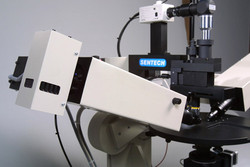
The high end SENresearch is designed for spectroscopic ellipsometry in the widest spectral range from 190 nm (deep UV) to 3,500 nm (NIR). Using the Step Scan Analyzer principle, the SENresearch measures thin film thickness, refractive index, extinction coefficient, and related properties of bulk materials, single layers, and multi layer stacks. The SENresearch is adapted to anisotropy, generalized ellipsometry, Mueller Matrix, and scatterometry. Download PDF
SENpro: Cost-effective spectroscopic ellipsometry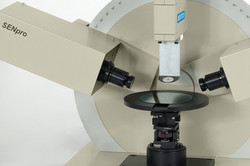
The SENpro ellipsometer is the smart solution to spectroscopic ellipsometry applications. It features a goniometer with angles of incidence in 5 °-steps. Easy operation, rapid measurement, and intuitive data analysis are combined in a cost-effective design for measuring thickness and optical constants of single films and multilayer stacks.
SENDIRA: Infrared spectroscopic ellipsometry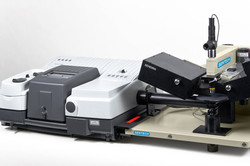
Vibrational spectroscopy is featured by the FTIR ellipsometer SENDIRA. Measuring the absorption bands of molecular vibrational modes in the infrared, the orientation of long molecule chains and the composition of thin films are analysed. Infrared spectroscopic ellipsometry is suited for measuring charge carrier concentration of conducting films.
SENDURO: Automated spectroscopic ellipsometry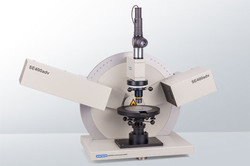
Automated spectroscopic ellipsometry by SENDURO® comprises recipe based quick data analysis within a few seconds. The ellipsometer is designed for easy operation: Placing the sample, automatic sample alignment, automated measurement and analysis, result. Using spectroscopic ellipsometry in the automatic mode is perfectly suited for routine applications in quality control and R&D.
SpectraRay/3: Spectroscopic ellipsometry software
The spectroscopic ellipsometry software SpectraRay/3 is designed focusing on an intuitive workflow. Therefore, SpectraRay/3 comprises a recipe mode with a two-step action (start measurement, result) and an interactive mode for step-by-step data analysis. The comprehensive package of SpectraRay/3 supports generalized ellipsometry, Mueller Matrix formalism, scatterometry (3D profiler), anisotropy, and simulations.
CLICK HERE - Laser Ellipsometry
Laser Ellipsometry
Laser Ellipsometer SE 400adv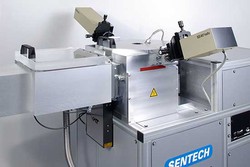
The laser ellipsometer SE 400adv measures thickness and refractive index of transparent thin films, featuring measurement speed, Sub-Angstrom precision in thickness, and per mille accuracy in refractive index determination. Multiple angle measurements allow the characterization of absorbing films using the laser ellipsometer SE 400adv.
CER Ellipsometer SE 500adv
The CER ellipsometer SE 500adv combines a laser ellipsometer and a reflectometer in one system. This combination allows zero degree reflectometry for fast thin film analysis and the unambiguous thickness determination for transparent films extending the measurable thickness range to 25 µm with the Sub-Angstrom precision of a laser ellipsometer.
In situ Laser Ellipsometer SE 401
The in situ laser ellipsometer SE 401 is designed for monitoring in situ deposition and etch processes and to measure thickness and refractive index of layers under vacuum.
Electron Microscopy - Click HERE for Product Page
SNE - 4500 M - High Resolution Table-top SEM (x100K)
Cost-effective Table-top SEM with Max. 10,000x of magnification by Miniaturizing modules. Capable of scanning images with high resolution of 5nm by installation of Variable Aperature with ease of use.
CLICK HERE - SNE - 3200 M - Highly Efficient Table-top SEM (x60K)
Entry-level Table-top SEM with 15nm resolution & 60,000x magnification. Able to use for quality control, R&D and educational purposes with various detectors. Capable of creating surface inforation images (SE), and material information images (BSE).
TEM and SEM Sample Preparation - Click HERE for Product Page
DESK V / TSC - Sample Coater
- Fully automated system
- Tilt/rotate option
- Minimize sample charge on non-conductive samples
- Reduce e-beam damage
- Increase secondary electron emissions
Desk V coating systems are available in two versions: Desk V HP and Desk V TSC.
The Desk V TSC, the turbo molecular-pumped sputter coater option, is a high-resolution unit suitable for oxidizing and non-oxidizing metals. This magnetron sputter unit precisely deposits a conductive coating for scanning electron microscopy (SEM) and transmission electron microscopy (TEM) sample preparation.

CLICK HERE - Bench Top Turbo
- Carbon Coating
- Sputtering
- AC glow discharge
- Low-voltage thermal evaporation
The Denton Vacuum Bench Top™ Turbo is a capable full-range low-voltage thermal evaporation platform engineered for a wide variety of thermal evaporation applications. It can also be configured for high resolution sample preparation.
The Bench Top Turbo is the ideal compact low-voltage thermal evaporator for both routine and complex carbon coating applications. The Bench Top Turbo also supports sputtering applications for high resolution analysis or other applications.

CLICK HERE - DV-502
- Rotary shadowing for metals and carbon
- Recipe development
- Small scale production
- Forensic and failure analysis
- High vacuum gate valve for rapid cycling
- Diffusion or tubro pump options
- Dedicated sputter or evaporation capability
- Integrated thickness monitors and controllers
- AC glow for sample cleaning
With rapid cycle times, on-board deposition control and a large deposition zone, the DV-502 gives users a flexible, high vacuum evaporation or sputtering system equipped for a wide range of applications.

[youtube]https://www.youtube.com/watch?v=HSGLZTL6YsA&[/youtube]
Ion Sputter Coater
- Fast and easy coating method (Start button > Automatic vacuum > Plasma Coating > Vent)
- Sample loading size – max. 50mm
- Target Material – Au (Gold), Pt (Platinum)
- Real time displaying current value
- Time setting as user wants
- Minimize installation place with small vacuum pump
- Current, Vacuum Setting / Save recipes function
Specifications (MCM-100 / MCM-200)
- Target Material : Au, Pt
- Target Electrode Size : D – 50mm
- Chamber Size : 120mm x 65mm | 130mm x 110mm
- Sample Table Size : 50mm
- Electrode-Sample Table Interval : 35mm
- Dimensions : 180(W) x 310(D) x 310(H) / 15kg | 505(W) x 310(D) x 250(H) / 10kg
Surface Analysis Systems - Click HERE for Product Page
PHI Range
At Scitek we provide a range of products supplied by Physical Electronics a sub-division of ULVAC PHI. We provide a variety of their scanning technologies ranging from the PHI 710 Scanning Auger Nanoprobe to the PHI VersaProbe II Scanning XPS Microprobe.
PHI 710 Scanning Auger Nanoprobe
Used for high performance spectral analysis, imaging and sputter depth profiling of complex materials including nanomaterials, electronic devices and catalysts. The 710′s field emission electron source provides extremely high resolution imaging, the addition of the coaxial geometry relating to the electron column and cylindrical mirror analyser enables sensitivity over a broad range of angles therefore ensuring rapid and complete analysis.
CLICK HERE - MicroCMA
An affordable surface analysis instrument that is both quantitative and surface sensitive, being extremely compact this instrument allows for makes acquiring AES data simple. It is a non-scanning cylindrical mirror analyser which is designed towards AES applications, this includes the analysis of thin film composition, passive oxide thickness’s in semiconductors and metals, metal component thermal oxides and integrated circuit contamination.
CLICK HERE - ScientaOmicron : MULTISCAN Lab
One of our providers Omnicron NanoScience provides Scitek with high quality scanning probe microscopy associated devices. Categories supplied range from Low temperature SPM’s to entire labs dedicated to UHV SEM imaging with high performance STM and AFM.
MULTISCAN Lab
Termed the ‘ultimate tool’ by Omicron NanoScience, it enables the combination of various surface analysis techniques simultaneously and on the very same spot. A highly stable sample stage carries an atomic resolution STM/AFM, while simultaneous SEM enables rapid localisation and precise tip navigation on nanostructures. The use of a goniometer mounted stage allows for tilting SPM and sample together in order to optimise the signal for techniques such as SAM, SEMPA, or EBSD.
X-ray Fluorescence Analysis - Click HERE for Product Page
The Atlas Micro-XRF spectrometer (µXRF) from IXRF Systems introduces a new world of x-ray mapping and automation. The Atlas™ boasts the largest chamber volume and SDD detection area (150mm2) as well as the smallest spot size (5µ) available on the market. Additionally, the Atlas™ is complimented by the most comprehensive software suite including multi-point analysis, unattended automation, in-depth feature/image analysis, unprecedented mapping and reporting features, and much more. Models may be operated under air or vacuum as well as Helium flush for liquids and light element analysis.
Key Differentiation Features:
Comprehensive software suiteMultipoint/Multi-Area AutomationComplete Customization Control of AutomationSDD Detector Active Area up to 150mm2Larger Chamber Volume50kv/50 watt tubeSpot Size down to 10microns with anti-halo optics
CLICK HERE - XFR for SEM - ƒX Custom X-ray Source


The new ƒX SEM ™ custom x-ray source is designed exclusively for use on electron microscopes. The compact design, and slide mounting, allow very close coupling to the sample. The orientation yields high “flux” (x-rays) in small to large excitation areas on the sample surface. The ƒX SEM™ offers excitation areas 500μ to 25mm. The integrated high-voltage power supply operates up to a maximum power of 10 watts (35 kV and 0.1 mA depending on anode material). The close coupling provides XRF analytical results comparable to those from traditional “benchtop” or “standalone” units. The ƒX SEM™ is designed so that it does not interfere with the normal operation of the electron microscope, including the use of the electron beam on the same sample, at the same time collecting all elements simultaneously.
No special cooling is required.
Electron beams (from scanning electron microscopes) produce very high backgrounds hiding the trace elements in the sample. X-rays, from a true “x-ray” source don’t have this effect. Using the ƒX SEM™ low ppm levels of elements can be easily identified, quantified, and even producing trace level x-ray maps to view elemental distribution of trace elements in your sample.
CLICK HERE - SDD Detectors
IXRF's range of electronically cooled (LN free) Silicon Drift Detectors are optimized when coupled with an innovative ethernet based digital pulse processor. Specially configured to each customer, IXRF SDD detectors provide exceptional and stable performance over a wide range of input count rates to produce rapid x-ray maps.
The SDD detector is available in both EDS (SEM mounted with slide assembly) and XRF (various designs, no slide) formats. Choice of window materials are available, from Beryllium (8um) to Thin Polymer (for light element x-ray transmission) and sensor active areas of 10mm2 to 60mm2 area offered. In addition, all of our SEM SD versions are vibration free
For further enquires please contact us on contact@scitek.com.au or on our contact page.



































